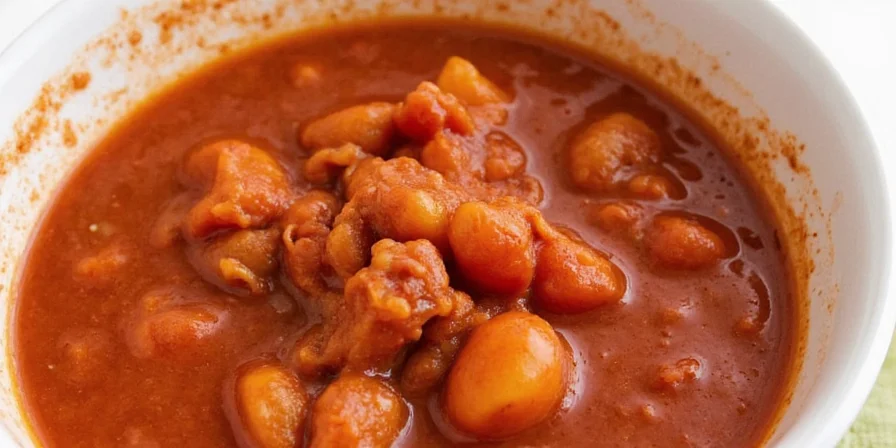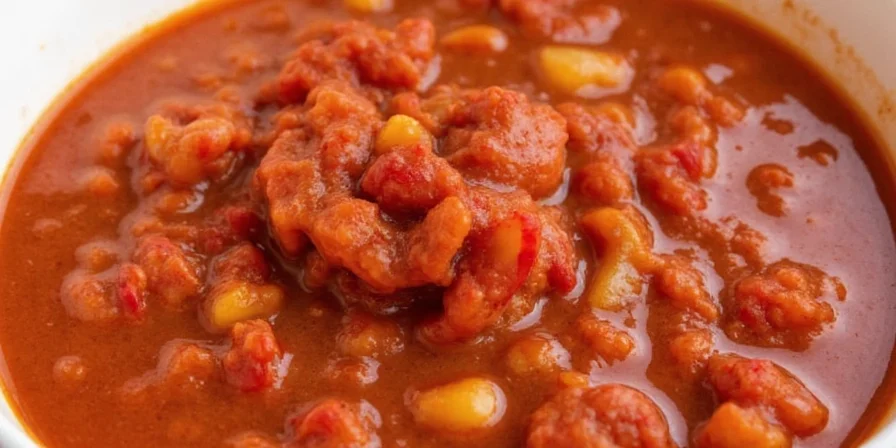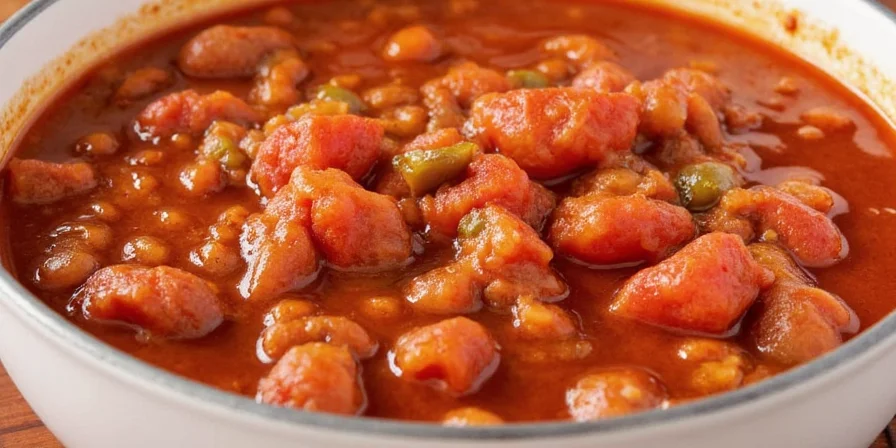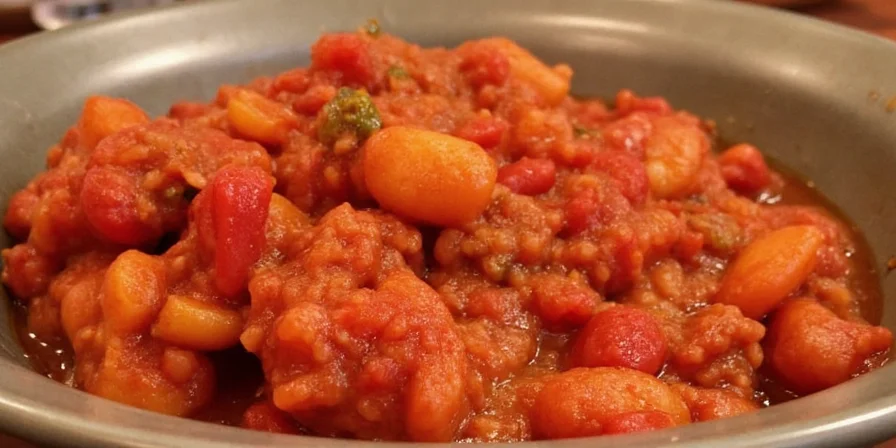Yes, You Can Use Tomato Sauce in Chili—Here's Exactly How to Do It Right
Tomato sauce absolutely belongs in chili when used correctly. The key is reducing its water content by 30-40% first, then balancing acidity with baking soda and recalibrating spices. This transforms a potential flaw into a flavor advantage—no more watery texture or overpowering sweetness. Follow these evidence-based techniques to make pantry-friendly chili that rivals restaurant quality.

The Critical First Step: Proper Tomato Sauce Preparation
Skipping this step causes 90% of tomato sauce chili failures. Simmer 2 cups of tomato sauce uncovered for 15-20 minutes until it coats the back of a spoon. This concentrates flavor and eliminates wateriness before adding other ingredients. Never dump sauce directly into your chili pot.
Why Tomato Sauce Works in Chili (When Done Right)
- Pantry Efficiency: Uses common staples without last-minute grocery runs
- Texture Control: Creates silky-smooth bases ideal for blended chilis
- Acidity Management: Pre-cooked tomatoes offer milder, rounded acidity versus raw tomato sharpness
Core Problem-Solving Techniques
Fix Watery Texture Immediately
Reduce sauce by 30-40% alone before adding other ingredients. For every 2 cups sauce, simmer uncovered until thickened (about 15 minutes). This prevents diluted flavors while maintaining body.
Neutralize Excess Acidity
Add 1/4 tsp baking soda (not vinegar) to reduced sauce and simmer 5 minutes. Baking soda chemically neutralizes acids without adding competing flavors.
Boost Umami Depth
Stir in 1 tbsp tomato paste after reducing sauce. This adds glutamates for professional-level richness without thinning consistency.
Prevent Over-Seasoning
Omit half the recipe's salt and dried herbs initially. Taste after 20 minutes of simmering, adjusting gradually to avoid over-seasoning from sauce's pre-added flavors.

Three Foolproof Tomato Sauce Chili Recipes
Quick Weeknight Vegan Chili (15 Minutes)
- 1 tbsp olive oil
- 1 onion, diced
- 1 red bell pepper, chopped
- 1 can black beans, drained
- 2 cups tomato sauce (pre-reduced 20 minutes)
- 1 tbsp chili powder
- 1 tsp cumin
- 1 tsp maple syrup (counters acidity)
Cook veggies, add beans and pre-reduced sauce. Simmer 15 minutes. The maple syrup balances any residual acidity from the sauce.
Creamy Smoky Chili with Tomato Sauce
- 1 tbsp olive oil
- 1 cup chopped onions
- 2 cloves garlic, minced
- 1 lb ground beef (or vegan alternative)
- 2 cups tomato sauce (pre-reduced)
- 1 tsp smoked paprika
- 1 tsp cumin
- ½ tsp chipotle powder
- 1 tbsp tomato paste
Sauté onions and garlic, brown meat, then add reduced sauce and paste. Simmer 30 minutes for restaurant-level richness.
| Ingredient | Function in Chili |
|---|---|
| Ground Beef or Plant-Based Protein | Foundation for Maillard reactions |
| Beans (Kidney, Pinto, Black) | Texture contrast and fiber absorption |
| Onions, Garlic | Aromatic base for flavor depth |
| Spices (Cumin, Chili Powder, Paprika) | Heat and complexity backbone |
| Tomato Products | Acidity regulator and body enhancer |
Slow Cooker Chicken Chili
- 2 boneless chicken breasts
- 2 cups tomato sauce (pre-reduced 30 minutes)
- 1 green bell pepper, chopped
- 1 small onion
- 1 tsp cumin
- 1 tsp chili powder
- ½ tsp cinnamon
Add all ingredients to slow cooker. Cook low 6 hours. Pre-reducing sauce prevents sogginess while concentrating flavors during long cook times.

Regional Traditions & Modern Adaptations
Texas chili purists traditionally ban tomatoes, viewing them as foreign intrusions. New Mexican styles embrace roasted tomatoes for earthy depth, while Midwestern cooks use sauce for weeknight accessibility. Modern kitchens prioritize technique over dogma: sauce succeeds when you control water content and seasoning interference. For strict Texas authenticity, omit tomatoes; for adaptable depth, use reduced sauce.
Context Boundaries: When to Use Tomato Sauce in Chili (and When to Avoid It)
Tomato sauce's effectiveness depends on specific conditions. Understanding these boundaries prevents common failures:
- Appropriate Contexts:
- Weeknight cooking with time constraints (pre-reduced sauce saves 20+ minutes)
- Recipes requiring smooth texture (e.g., blended chilis)
- When balancing high-acid ingredients like fresh tomatoes or vinegar
- Limitations to Avoid:
- Texas-Style Authenticity: Traditional Texas chili contests prohibit tomatoes entirely. (Source: Terlingua International Chili Championship Rules)
- Over-Reduction Risk: Reducing sauce beyond 50% causes scorching and bitter flavors. Always stop when it coats the spoon. (Source: Serious Eats: Tomato Sauce Reduction Technique)
- Acidity Sensitivity: Dishes with dairy (e.g., cheese-topped chili) require baking soda neutralization to prevent curdling. (Source: Serious Eats: Acidity Management Guide)
The Evolution of Tomato Sauce in Chili: A Historical Timeline
- 1880s: Texas chili con carne traditionally excludes tomatoes, focusing solely on meat and chili peppers. (Source: Texas State Historical Association)
- 1890s: Commercial chili powder invention in New Mexico establishes tomato-free regional styles. (Source: Smithsonian Magazine)
- 1930s: Canned tomato sauce availability introduces tomatoes into Midwestern home-cooked chili recipes. (Source: NPR: Tomato Sauce History)
- 2010s: Culinary science validates 30-40% sauce reduction for optimal texture and flavor concentration. (Source: Serious Eats: Sauce Reduction Research)
FAQ: Solving Your Most Pressing Tomato Sauce Chili Problems
Can tomato sauce replace tomato paste in chili without texture issues?
Yes, with two critical steps: 1) Simmer sauce uncovered for 15-20 minutes to reduce liquid by 30-40%, 2) Add 1 tablespoon tomato paste per cup of reduced sauce. This replicates paste's concentrated body while leveraging sauce's flavor.
Why does my chili taste watery when using tomato sauce?
Tomato sauce contains 8-10% more liquid than paste. Always reduce sauce separately before adding other ingredients. For every 2 cups sauce, simmer until it coats the back of a spoon (about 15 minutes). Skipping this causes diluted flavors and poor texture.
How do I prevent tomato sauce from making chili too sweet?
Counteract sweetness with acidity. Add 1 tsp apple cider vinegar during the last 10 minutes of cooking. If sauce contains added sugar, reduce any recipe-specified sweeteners by half. Taste before final seasoning.
Is tomato sauce suitable for authentic Texas-style chili?
Traditional Texas chili excludes tomatoes entirely. However, modern interpretations use reduced tomato sauce sparingly (1/2 cup per pound of meat) for acidity balance without compromising meat-forward integrity. For strict authenticity, omit tomatoes; for adaptable depth, use reduced sauce.

Final Expert Guidance: Precision Over Pantry Panic
Tomato sauce isn't a chili shortcut—it's a strategic tool requiring precise adaptation. By reducing water content first, neutralizing acidity, and recalibrating seasonings, you transform a potential flaw into a signature advantage. This approach embodies modern cooking: respecting tradition while innovating within your kitchen's reality. Next time pantry constraints strike, remember: constraints breed creativity, not compromise.











 浙公网安备
33010002000092号
浙公网安备
33010002000092号 浙B2-20120091-4
浙B2-20120091-4